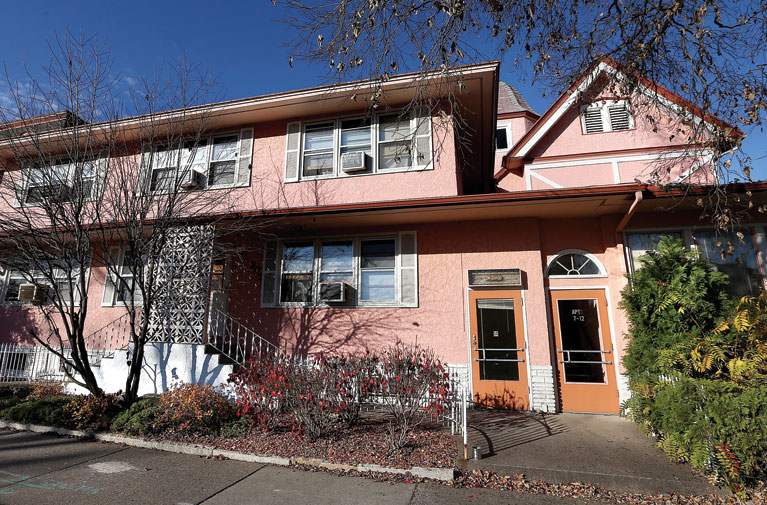LA CROSSE, Wis. — Nancy Wernecke finds comfort in the fact that her childhood home’s future includes housing single moms and their children, preserving the laughter and memories that the walls of the “Pink Palace” have absorbed instead of letting them fall to a developer’s wrecking ball.
“I’m absolutely ecstatic,” Wernecke told the La Cross Tribune of the plans to re-imagine the building as Three Rivers Scholars House, providing a home to single mothers who are in school and their children.
“I consider myself a humanitarian and social activist, and repurposing it that way warms my heart,” the 64-year-old Wernecke said during a phone interview from Portland, Ore., where she moved nearly three decades ago.
The news is, indeed, more heartwarming than the scenario discussed when Wernecke was back in town for a farewell ceremony to the building in May 2015.
“After the ceremony, there was speculation about redevelopment,” she said. “I’m very pleased about this — it’s fabulous.”
That is a fitting adjective for a building that is as mysterious from the outside as it is jaw-dropping on the inside, with its kitchen, bedrooms, bathrooms, an indoor pool that used to be outdoors and other features that were installed in the 1960s and ’70s and have survived the eras since then to a new time when retro is cool.
Three Rivers Scholars House is being developed under a partnership among Shelter Development Inc., the University of Wisconsin-La Crosse’s Self Sufficiency Program and Hope Academy at the Family and Children’s Center to provide housing for single mothers as long as they are in educational programs.
Wernecke’s first memory of the house, when she was 3 1/2 or 4 and moved in with her parents, the late Dale and Pat Wernecke, was that the previous owner’s large dog kept coming to the front door and trying to get in, she said with a laugh.
That was before the Werneckes had the swimming pool installed, when the back yard had an apple tree, a pear tree, lilacs, pussy willows and a playhouse, she said.
“Every winter, Dad would flood the back yard to make an ice rink” for her and her younger sister, Julie Wernecke, said. “He would skate with us, holding onto a chair” for balance.
Next door was the home where Pat grew up, a house from which Nancy recalls her dad rescuing a woman from the second floor when the house burned down.
“Dad was up on the ladder, and the woman was a family friend” with limited mobility, she said.
Dale had wings built on either side of the 1880s-era house for rental apartments, although her grandparents lived in one for a while, and Julie and her family occupied another, she said.
“Eventually, dad moved full force into rental apartments. He owned his own construction firm and built or bought apartments,” she said. “He had buildings in five states.”
Eventually, he would buy several neighboring houses, including that of Ruby Stranberg, and the gas station on the corner, leveling them to make an expansive yard.
While Dale was building his empire, Pat was busy decorating his palace with an eclectic approach that included top-drawer kitchen appliances that remain at their stations, imitation palms and other foliage crowded leaf to leaf, statuary inside and out, colorful shag carpet throughout and wildly creative spins in rooms that still harbor the decor.
Walking into the main house is a bit like entering an episode of “The Twilight Zone,” expecting to hear Rod Serling’s haunting voice warning that you are arriving in another dimension that time forgot.
One room had an African motif, and still another, a Japanese theme, Nancy said, although she doesn’t recall her parents traveling to either of those parts of the globe.
A room that appears to be a media center has a hole in a wooden wall that might have held a TV no bigger than 19 inches, with holes on either side for speakers.
Another room, in the basement, has “The Age of Aquarius” painted on the wall, along with go-go dancers, guitars, old-fashioned phones, musical notes and phonograph records of a bygone era.
“That originally was built as a bomb shelter in an age when there was fear of everything. We called it ‘The Pad,’ and when we were teenagers, we had black lights and waterbeds there,” said Nancy. “It was a bit of a party place where we would hang out and smoke cigarettes,” she said.
Pat didn’t have formal interior design training, Nancy said. But she had a passion for the art and did it her way, Nancy said, adding, “My sister had the same gene for decorating.”
Pat decorated Nancy’s room with a poodle motif, without asking her daughter’s preference, which Nancy explained by saying, “She got what she thought we needed. She had us in her mind, looking through her own lens for decorating.”
When the Werneckes had the pool enclosed, “it was a whole new opportunity” for a redesign, including large statues at corners of the pool.
“She decided to create a Shangri La for the entry, and off she went to it again,” Nancy said of the entry still labeled Shangri La in stained glass that is typical of several rooms.
Nancy, who has a degree from Viterbo University School of Nursing in La Crosse and a graduate degree from the University of Wisconsin-Madison in psychiatric mental health nursing, practiced for a time at what is now Gundersen Health System in La Crosse and has had a private practice in Portland for 19 years.
She traveled regularly back to La Crosse as her parents’ health failed. Dale died in the Pink Palace at the age of 82 on Feb. 23, 2011. Pat died there on Sept. 28, 2013.
Nancy believes they would be happy to see the building as it enters its next phase, sheltering women and children.
“The repurposing of the Pink Palace would be much in keeping with my parents’ legacy of kindness and generosity,” she said.











